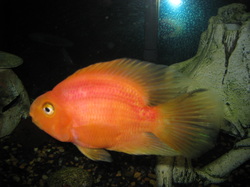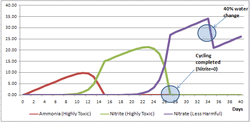Central American Cichlids
Cycling

Cycling can be tricky so I am going to make it easy for you to understand.
You must get a Master Test Kit, the dip stick are not reliable.
So lets get started!
You need to know the basics first and their definitions.
Definitions
Ammonia - Ammonia is a toxic substance that builds up in the aquarium, particularly in a newly setup tank. Ammonia is the first step in thenitrogen cycle, and is produced as a byproduct of protein breakdown such as, uneaten fish food and fish excreta.
Nitrite - Nitrite is an extremely toxic nitrogenous substance formed by certain bacteria in the process of ammonia oxidation in the aquarium.
Nitrate - Organic waste in the fish tank results in rising nitrates. Nitrates are less toxic then ammonia and nitrite, however, nitrates are a natural fertilizer and therefore readily available to algae cells.
pH (Power of Hydrogen) - pH is a measure of hydrogen ion concentration; a measure of the acidity or alkalinity of a solution.
Let's Get Cycling
Get a couple hardy fish like Giant Danios and put them in the tank. First we have to discuss water parameters so you understand what your doing and when it is okay to add your fish.
Frist you will have a spike of Ammonia then it will decrease, then a spike of Nitrites and then it will decrease then a Nitrate reading.
1. Ammonia: Is toxic to fish
2. Nitrites: is toxic to fish
3. Nitrates: is toxic to fish over 40ppm.
While your danios are in the tank test the water every couple of days. Clean the tank once a week , usually 30% to 50% is sufficient and do water changes every 2 days 30%. You will notice the Ammonia start to creep up.That is when the fish start to start to show symptoms of distress. A water change is in order.
Then usually a week later your Ammonia will creep back down and you will get a rise of Nitrites. Nitrites are hard on fish but not as hard as Ammonia. You still need to do a water change. In about a week your Nitrites will decrease until the reach 0ppm.
Now your Ammonia should be 0ppm
Now your Nitrates should be 0ppm
Now you should get a reading on Nitrates
This means you are cycled.
Once your Ammonia and Nitrites reach 0ppm and you have a reading on your Nitrates (hopefully below 40ppm) you are cycled. It takes a long time, be patient and don't add to many fish at once.
You must get a Master Test Kit, the dip stick are not reliable.
So lets get started!
You need to know the basics first and their definitions.
Definitions
Ammonia - Ammonia is a toxic substance that builds up in the aquarium, particularly in a newly setup tank. Ammonia is the first step in thenitrogen cycle, and is produced as a byproduct of protein breakdown such as, uneaten fish food and fish excreta.
Nitrite - Nitrite is an extremely toxic nitrogenous substance formed by certain bacteria in the process of ammonia oxidation in the aquarium.
Nitrate - Organic waste in the fish tank results in rising nitrates. Nitrates are less toxic then ammonia and nitrite, however, nitrates are a natural fertilizer and therefore readily available to algae cells.
pH (Power of Hydrogen) - pH is a measure of hydrogen ion concentration; a measure of the acidity or alkalinity of a solution.
Let's Get Cycling
Get a couple hardy fish like Giant Danios and put them in the tank. First we have to discuss water parameters so you understand what your doing and when it is okay to add your fish.
Frist you will have a spike of Ammonia then it will decrease, then a spike of Nitrites and then it will decrease then a Nitrate reading.
1. Ammonia: Is toxic to fish
2. Nitrites: is toxic to fish
3. Nitrates: is toxic to fish over 40ppm.
While your danios are in the tank test the water every couple of days. Clean the tank once a week , usually 30% to 50% is sufficient and do water changes every 2 days 30%. You will notice the Ammonia start to creep up.That is when the fish start to start to show symptoms of distress. A water change is in order.
Then usually a week later your Ammonia will creep back down and you will get a rise of Nitrites. Nitrites are hard on fish but not as hard as Ammonia. You still need to do a water change. In about a week your Nitrites will decrease until the reach 0ppm.
Now your Ammonia should be 0ppm
Now your Nitrates should be 0ppm
Now you should get a reading on Nitrates
This means you are cycled.
Once your Ammonia and Nitrites reach 0ppm and you have a reading on your Nitrates (hopefully below 40ppm) you are cycled. It takes a long time, be patient and don't add to many fish at once.
pH (Power of Hydrogen)

pH
The pH scale is used to measure the degree to which your aquarium’s water is acidic, alkaline, or neutral. The scale ranges from 0 to 14 with 0 being the most acidic, 7 being neutral, and 14 being the most basic. Most fish thrive in a pH of 6.4-7.8. However, there are exceptions.
You pH need to be stable at all times. If not the fish could suffer, fluctuations in pH can make them sick. Depending on the species of fish you can raise or decrease your pH. The key to success is keeping it stable.
Central American Cichlids will thrive at a ph of 7.0 to 8.0.
You pH need to be stable at all times. If not the fish could suffer, fluctuations in pH can make them sick. Depending on the species of fish you can raise or decrease your pH. The key to success is keeping it stable.
Central American Cichlids will thrive at a ph of 7.0 to 8.0.

